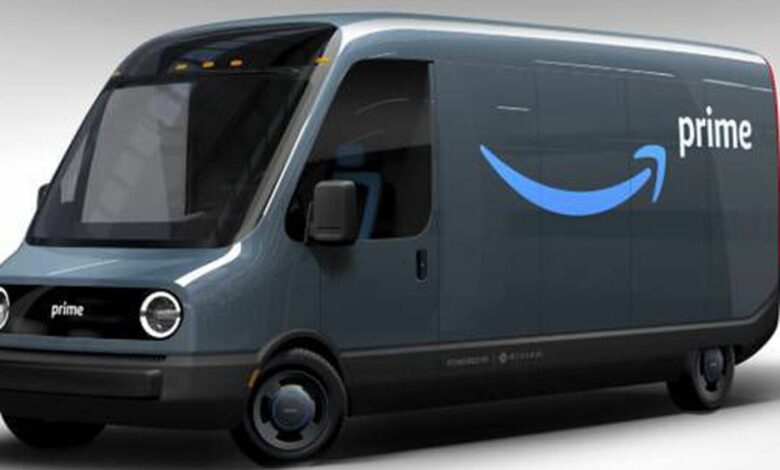Why Amazon desperately needs electric vehicles now?

With Elon Musk overtaking Amazon founder Jeff Bezos to be the richest man in the world and Musk’s co-founded Electric vehicle company Tesla taking over Facebook in the list of world’s most valuable companies in the early days of 2021, the electric vehicle industry has been getting better exposure and recognition throughout the world.
However, in the electric vehicle industry, there’s another niche that goes unnoticed. An even more financially rewarding use of technology are the vans delivering your online shopping orders, constituting an essential part of the automotive industry. However, the fact that this niche of the multi-trillion dollar industry is easily ignored is changing and that too, at a very fast pace. Evidently, the private-based Rivian Automotives raised another USD 2.65 billion to fund its rollout of electric vehicles, bringing the valuation to a total of USD 27.6 billion. The rollout mentioned also includes a delivery truck for its e-commerce stakeholder, Amazon.com. At the same time, General Motors announced its expansion, with a branch named Brightdrop to work on supplying electric vehicles to the delivery companies’ industry. General Motors claimed to deliver 500 vehicles later this year by getting in a contract with their launch partner, FedEx.
General Motor’s unit Brightdrop raised another USD 2 billion recently to take its total valuations to the heavy USD 30 billion, including investment from Microsoft, setting a straight-up post-bankruptcy stock record.
If this wasn’t enough, reports suggest how start-ups are rushing into the promising niche like the California start-up Canoo and the British start-up Arrival. Rooting from capital from the exuberant stock market, California Start-up Canoo went public with an aim to focus on the proclaimed last-mile delivery to get goods to your door, last December. The British start-up, Arrival, that we talked about, has received major funding and big consignment from the United Parcel Service and has plans to follow suit later this quarter.
This new hype to the industry space came owing to the advent of COVID-19 pandemic. With people being behind closed door, e-commerce took the floor and reached the sky, with Vans being just an aid result of the process. The impact of e-commerce on the economy and its growing overall trend can be seen by an almost 7% segment increase in retail sales business in one year, throughout the world. And thanks to the growth of the e-commerce industry and thus, delivery market, the sales of vans also increased manifold and the segment also got its due recognition, in terms of investment and opportunities
Another ode to the growing opportunities in the industry is due to increasing awareness on climate change and thus, actions to convert to green fuel. This implies that the trend of vehicle electrification being taken up throughout the world also helped flourish the industry. Companies working on similar lines with ones like UPS, DHL and FedEx have all come together and committed to reduce carbon emissions as much as possible, for which they need electric vans and delivery trucks to take over. One of the likes of UPS, DHL and FedEx is Amazon, which has also joined hands in the commitment and has thus ordered 100,000 electric delivery vans from its stakeholder Rivian. The first of the 100,000 booked by Amazon from Rivian is due later this year. However, big companies like Amazon, no matter how much they claim otherwise, do not spend such a huge deal only for social reasons. The financial aspect here is the ability if delivery vehicles to lend themselves to Electric Vehicle industry, to a much larger extent than passenger vehicles. Electric Vehicles’ unique selling proposition of low running and maintenance expenses come as added benefits to the deal. In a move with respect to this, logistic operators and small contractors are also heartily trying to examine careful cost calculations, both production an dover lifetime of the vehicles.
The two start-ups Arrival and Canoo have also since claimed to offer savings on the cost relative to the common internal-combustion equivalents, with proclamations of production versions to be launched in 2022 and 2023, for both the start-ups, respectively. One possible reason to believe the claims of careful cost calculations is because of the fact that delivery vans don’t particularly need the long driving ranges that are required for passenger cars.
The particular distinction between expenses of electric cars and electric delivery vans root from the fact that the batteries required in electric cars should be big enough to travel a considerable amount of distance without reasonable doubt of running out or having to recharge. Delivery vans, on the other hand, cover only fixes distances, the extent of which is known beforehand. This gives delivery companies the leverage to choose the required battery size for their vehicle according to their requirement, and need not necessarily spend on batteries bigger than their need, unlike electric cars. Delivery vehicles can also be recharged over time and during breaks.
Another advantage that works in favour of cost efficiency calculations of electric vehicles is the facility to integrate software with the electronic systems. This implies that more the tools for cost-efficient routing, driving or loading, the more will be the business attraction they concur. However, it is not a win-win for everybody, like the current van suppliers, especially like Ford that captures almost half the European market. To stay in the market, it would need to convert its Transit cargo van into the electric ones.
The batteries the electric vehicles use, the lithium-ion batteries, aren’t strong enough to serve heavy trucks, both delivery and non-delivery. They’re not also inexpensive enough yet to make long-range electric vehicles cost-competitive with the currently dominant internal combustion ones. As a result, the electric vans pose an amazing opportunity to conquer the market for a financially reasonable advent of the new technology in the time to come. It is thus supposedly argued that the delivery companies focusing on local logistics of cost efficiency may be in a fairly stable position to bring home the technology.




